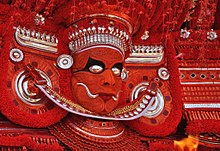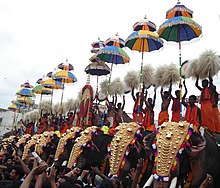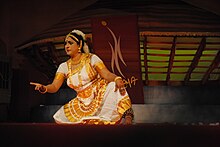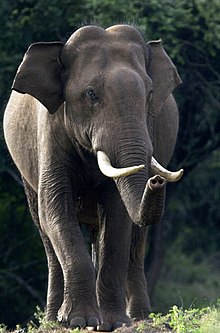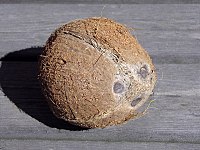User:Jstalins/sandbox
Culture
[change | change source]The culture of Kerala is an integral part of Indian culture.[1] It is derived from a combination of Aryan and Dravidian cultures.[2][3] It was elaborated through centuries of contact with neighbouring and overseas cultures.[4] The Malayalam calendar, a solar calendar started from 825 CE in Kerala,[5] is used in planning agricultural and religious activities.[6] Malayalam, one of the classical languages in India, is Kerala's official language.[7] Over a dozen other scheduled and unscheduled languages are also spoken.[8]
Festivals
[change | change source]Many of the temples in Kerala hold festivals on specific days of the year.[9] Some festivals include Poorams, the best known of these being the Thrissur Pooram.[10] "Elephants, firework displays and huge crowds" are the major attractions of Thrissur Pooram.[11] Other known festivals are Makaravilakku,[12] Chinakkathoor Pooram, Attukal Pongala and Nenmara Vallangi Vela[13] Other than these, festivals locally known as utsavams are conducted by many temples mostly on annual basis. Temples that can afford it will usually involve at least one richly caparisoned elephant as part of the festivities. The idol in the temple is taken out on a procession around the countryside atop this elephant. When the procession visits homes around the temple, people will usually present rice, coconuts, and other offerings to it.[14] Processions often include traditional music such as Panchari melam or Panchavadyam.[15]
Onam
[change | change source]Onam is a harvest festival celebrated by the people of Kerala and is reminiscent of the state's agrarian past.[16][17] It is a local festival of Kerala[18] consisting of a four-day public holidays; from Onam Eve (Uthradam) to the fourth Onam Day.[19] Onam falls in the Malayalam month of Chingam (August–September)[20] and marks the commemoration of the homecoming of King Mahabali.[21] The total duration of Onam is 10 days and it is celebrated all across Kerala. It is one of the festivals celebrated with cultural elements such as Vallam Kali,[22] Pulikali,[23] Pookkalam,[24] Thumbi Thullal[25] and Onavillu.[26]
Dance
[change | change source]Kerala is home to a number of performance arts. These include five classical dance forms: Kathakali, Mohiniyattam, Koodiyattom, Thullal and Krishnanattam, which originated and developed in the temple theatres during the classical period under the patronage of royal houses.[27] Kerala natanam, Thirayattam,[28] Kaliyattam, Theyyam, Koothu and Padayani are other dance forms associated with the temple culture of the region.[29] Some traditional dance forms such as Margamkali and Parichamuttukali are popular among the Syrian Christians and Chavittu nadakom is popular among the Latin Christians,[30][31] while Oppana and Duffmuttu were popular among the Muslims of the state.[32]
Music
[change | change source]The development of classical music in Kerala is attributed to the contributions it received from the traditional performance arts associated with the temple culture of Kerala.[33] The development of the indigenous classical music form, Sopana Sangeetham, illustrates the rich contribution that temple culture has made to the arts of Kerala.[33] Carnatic music dominates Keralite traditional music. This was the result of Swathi Thirunal Rama Varma's popularisation of the genre in the 19th century.[4] Raga-based renditions known as sopanam accompany kathakali performances.[34] Melam; including the paandi and panchari variants, is a more percussive style of music:[35] it is performed at Kshetram-centered festivals using the chenda. Panchavadyam is a form of percussion ensemble, in which artists use five types of percussion instrument.[35] Kerala's visual arts range from traditional murals to the works of Raja Ravi Varma, the state's most renowned painter.[33] Most of the castes and communities in Kerala have rich collections of folk songs and ballads associated with a variety of themes; Vadakkan Pattukal (Northern Ballads), Thekkan pattukal (Southern Ballads), Vanchi pattukal (Boat Songs), Mappila Pattukal (Muslim songs) and Pallipattukal (Church songs) are a few of them.[36]
Cinema
[change | change source]Malayalam films carved a niche for themselves in the Indian film industry with the presentation of social themes.[37][38] Directors from Kerala, like Adoor Gopalakrishnan, G. Aravindan, Bharathan, P. Padmarajan, M.T.Vasudevan Nair, K.G. George, Priyadarshan, John Abraham, Ramu Karyat, K S Sethumadhavan, A. Vincent and Shaji N Karun have made a considerable contribution to the Indian parallel cinema. Kerala has also given birth to numerous actors, such as Mohanlal, Satyan, Prem Nazir, Madhu, Sheela, Sharada, Miss Kumari, Jayan, Adoor Bhasi, Seema, Bharath Gopi, Thilakan, Mammootty, Vijaya Raghavan, Kalabhavan Mani, Indrans, Shobana, Nivin Pauly, Sreenivasan, Urvashi, Manju Warrier, Suresh Gopi, Jayaram, Murali, Shankaradi, Kavya Madhavan, Bhavana Menon, Prithviraj, Parvathy (actress), Jayasurya, Dulquer Salmaan, Oduvil Unnikrishnan, Jagathy Sreekumar, Nedumudi Venu, KPAC Lalitha, Innocent and Fahad Fazil. Late Malayalam actor Prem Nazir holds the world record for having acted as the protagonist of over 720 movies.[39] Since the 1980s, actors Mohanlal and Mammootty have dominated the movie industry; Mohanlal has won five National Film Awards (four for acting), while Mammootty has three National Film Awards for acting.[40] Malayalam Cinema has produced a few more notable personalities such as K.J. Yesudas, K.S. Chitra, M.G. Sreekumar, Vayalar Rama Varma, M.T. Vasudevan Nair, V. Madhusoodanan Nair and O.N.V. Kurup,[41] the last two mentioned being recipients of Jnanpith award, the highest literary award in India.[42] Resul Pookutty, who is from Kerala, is only the second Indian to win an academy award for sound design, for the breakthrough film Slumdog Millionaire.
Literature
[change | change source]Malayalam literature starts from the late medieval period and includes such notable writers as the 14th-century Niranam poets (Madhava Panikkar, Sankara Panikkar and Rama Panikkar),[43][44] and the 17th-century poet Thunchaththu Ezhuthachan, whose works mark the dawn of both the modern Malayalam language and its poetry.[45] Paremmakkal Thoma Kathanar and Kerala Varma Valiakoi Thampuran are noted for their contribution to Malayalam prose.[46][47][48] The "triumvirate of poets" (Kavithrayam): Kumaran Asan, Vallathol Narayana Menon, and Ulloor S. Parameswara Iyer, are recognised for moving Keralite poetry away from archaic sophistry and metaphysics, and towards a more lyrical mode.[49][50][51] In the second half of the 20th century, Jnanpith winning poets and writers like G. Sankara Kurup, S. K. Pottekkatt, Thakazhi Sivasankara Pillai, M. T. Vasudevan Nair and O. N. V. Kurup had made valuable contributions to the modern Malayalam literature.[52][53][54][55][56] Later, writers like O. V. Vijayan, Kamaladas, M. Mukundan, Arundhati Roy, Vaikom Muhammed Basheer, have gained international recognition.[57][58][59][60]
Cuisine
[change | change source]Kerala cuisine includes a wide variety of vegetarian and non-vegetarian dishes prepared using fish, poultry, and meat. Culinary spices have been cultivated in Kerala for millennia and they are characteristic of its cuisine.[61] Rice is a dominant staple that is eaten at all times of day.[62] A majority of the breakfast foods in Kerala are made out of rice, in one form or the other (idli, dosa, puttu, appam, or idiyappam), tapioca preparations, or pulse-based vada.[63] These may be accompanied by chutney, kadala, payasam, payar pappadam, appam, chicken curry, beef fry, egg masala and fish curry.[64] Porotta and Biryani are also often found in restaurants in Kerala. Thalassery biryani is popular as an ethnic brand. Lunch dishes include rice and curry along with rasam, pulisherry and sambar.[65] Sadhya is a vegetarian meal, which is served on a banana leaf and followed with a cup of payasam.[66] Popular snacks include banana chips, yam crisps, tapioca chips, Achappam, Unni appam and kuzhalappam.[67][68][69] Seafood specialties include karimeen, prawns, shrimp and other crustacean dishes.[70]
Thalassery Cuisine is varied and is a blend of many influences.
Elephants
[change | change source]Elephants have been an integral part of the culture of the state. Almost all of the local festivals in kerala include at least one richly caparisoned elephant. Kerala is home to the largest domesticated population of elephants in India—about 700 Indian elephants, owned by temples as well as individuals.[71] These elephants are mainly employed for the processions and displays associated with festivals celebrated all around the state. More than 10,000 festivals are celebrated in the state annually and some animal lovers have sometimes raised concerns regarding the overwork of domesticated elephants during them.[72] In Malayalam literature, elephants are referred to as the "sons of the sahya".[73] The elephant is the state animal of Kerala and is featured on the emblem of the Government of Kerala.[74]
Provincial symbols of Kerala
[change | change source]-
Provincial bird of Kerala
-
Provincial animal of Kerala
-
Provincial tree of Kerala
-
Provincial flower of Kerala
Festivals[75]
[change | change source]The most famous festivals held by Keralites are Onam, the harvest festival and Vishu, the Malayalam Calendar New Year. In addition to these, temples as well as churches hold festivals in several days of the year. A common tradition in all these festivals is the hosting of the holy flag, which is brought down on the last day of the festival. Some temple festivals are called poorams, and the most famous one among these is 'Thrissur Pooram'. The main attractions of poorams are firecrackers, traditional dance forms like 'Theyyam, Kathakali, Chakyar Koothu etc.'. Festivals are locally known as utsavams .
Tourism
[change | change source]Kerala is one of the biggest tourist attractions in India, both for Indians as well as foreigners. It has beautiful beaches, hill stations and extensive backwaters. Kerala is also known for its diverse nature.
Agriculture
[change | change source]- ↑ A. Sreedhara Menon (2008). Cultural Heritage of Kerala. D C Books. pp. 13–15. ISBN 978-81-264-1903-6. Retrieved 30 May 2015.
- ↑ A. Sreedhara Menon (1978). Cultural Heritage of Kerala: An Introduction. East-West Publications. p. 10.
- ↑ Contribution of Travancore to Karnatic Music. Information & Public Relations Department, Government of Kerala. 2004. pp. 7–37.
- ↑ 4.0 4.1 S. Bhagyalekshmy (2004). Contribution of Travancore to Karnatic Music. Information & Public Relations Department, Government of Kerala. Retrieved 6 January 2013.
- ↑ J. Devika (2005). Her-self: Early Writings on Gender by Malayalee Women, 1898–1938. Popular Prakashan. p. 5. ISBN 978-81-85604-74-9. Retrieved 17 November 2012.
- ↑ Kumar Suresh Singh (2004). People of India: Maharashtra. Popular Prakashan. p. 1524. ISBN 978-81-7991-102-0. Retrieved 17 November 2012.
- ↑ Thomas Benedikter (2009). Language Policy and Linguistic Minorities in India: An Appraisal of the Linguistic Rights of Minorities in India. LIT Verlag Münster. p. 90. ISBN 978-3-643-10231-7. Retrieved 18 November 2012.
- ↑ Cite error: The named reference
census2011-langreportwas used but no text was provided for refs named (see the help page). - ↑ Cultural Heritage of Kerala. D.C. Books. 2008. p. 76. ISBN 978-81-264-1903-6.
- ↑ World Encyclopaedia of Interfaith Studies: World religions. Jnanada Prakashan. 2009. pp. 704–710. ISBN 978-81-7139-280-3.
- ↑ "The stars of Pooram show are jumbos". The Hindu. Chennai, India. 26 May 2006. Retrieved 11 November 2007.
- ↑ Infokerala Communications Pvt. Ltd. (1 September 2013). Pilgrimage to Temple Heritage. Biju Mathew. p. 433. ISBN 978-81-921284-4-3.
- ↑ David Stott (10 April 2014). Kerala Footprint Focus Guide: Includes Kochi, Alappuzha, Thrissur, Periyar, River Nila. Footprint Travel Guides. p. 94. ISBN 978-1-909268-79-1.
- ↑ M. G. S. Narayanan; K. K. N. Kurup (1976). Historical Studies in Kerala. Department of History, University of Calicut. pp. 68–81.
- ↑ Rolf Killius (2006). Ritual Music and Hindu Rituals of Kerala. B.R. Rhythms. p. 61. ISBN 978-81-88827-07-7.
- ↑ Chummar Choondal (1980). Kerala Folk Literature. Kerala Folklore Academy.
- ↑ A Sreedhara Menon (1 January 2007). A Survey Of Kerala History. DC Books. pp. 80–. ISBN 978-81-264-1578-6.
- ↑ Pratiyogita Darpan (October 2006). Pratiyogita Darpan. Pratiyogita Darpan. p. 624.
- ↑ Purāṇam. All-India Kasiraja Trust. 2004. p. 17.
- ↑ Cultural Heritage of Kerala. D.C. Books. 2008. p. 66. ISBN 978-81-264-1903-6.
- ↑ Praveen, M. P. (8 September 2011). "Myth, mystique, and traditions of Onam". The Hindu. Retrieved 12 November 2015.
- ↑ IBP USA (3 March 2012). India Country Study Guide Volume 1 Strategic Information and Developments. Lulu.com. p. 110. ISBN 978-1-4387-7460-2.
- ↑ Infokerala Communications Pvt. Ltd. (1 September 2013). Pilgrimage to Temple Heritage. Biju Mathew. p. 535. ISBN 978-81-921284-4-3.
- ↑ A Biblical Approach to Indian Traditions and Beliefs. Armour Publishing Pte Ltd. 2008. p. 90. ISBN 978-981-4222-39-6.
- ↑ J Mohapatra (December 2013). Wellness In Indian Festivals & Rituals. Partridge Pub. p. 142. ISBN 978-1-4828-1690-7.
- ↑ Gouri Lakshmi Bayi (Princess.) (1998). Thulasi garland. Bharatiya Vidya Bhavan.
- ↑ Kala Menon (November 2004). "Classical Dance Art Forms of Kerala" (PDF). Sruti Ranjini. 14 (1): 11.
- ↑ "Thirayattam" (Folklore Text-Malayalam), State Institute of language, Kerala ISBN 978-81-200-4294-0
- ↑ A Sreedhara Menon (2008). Cultural heritage of Kerala. D C Books. p. 106. ISBN 978-81-264-1903-6. Retrieved 17 November 2012.
- ↑ Kāvālaṃ Nārāyaṇappaṇikkar (1991). Folklore of Kerala. National Book Trust, India. p. 146. Retrieved 17 November 2012.
- ↑ Asha Kasbekar (2006). Pop Culture India!: Media, Arts, And Lifestyle. ABC-CLIO. pp. 43–44. ISBN 978-1-85109-636-7. Retrieved 17 November 2012.
- ↑ Motilal (UK) Books of India (1 February 2008). Tourist Guide Kerala. Sura Books. p. 8. ISBN 978-81-7478-164-2. Retrieved 17 November 2012.
- ↑ 33.0 33.1 33.2 A. Sreedhara Menon (1982). The Legacy of Kerala. D C Books. pp. 48–51. ISBN 978-81-264-2157-2. Retrieved 30 May 2015.
- ↑ Richard Schechner; Willa Appel (25 May 1990). By Means of Performance: Intercultural Studies of Theatre and Ritual. Cambridge University Press. p. 145. ISBN 978-0-521-33915-5. Retrieved 18 November 2012.
- ↑ 35.0 35.1 Simon Broughton; Mark Ellingham; Richard Trillo (2000). World Music Volumn 2 Latin and North America, Caribbean, India, Asia and Pacific: The Rough Guide. Rough Guides. p. 97. ISBN 978-1-85828-636-5. Retrieved 18 November 2012.
- ↑ A. Sreedhara Menon (1982). The Legacy of Kerala. D C Books. p. 41. ISBN 978-81-264-2157-2. Retrieved 30 May 2015.
- ↑ Menon, Sreedhara (2008). Cultural Heritage of Kerala. D C Books. pp. 128–129. ISBN 978-81-264-1903-6. Retrieved 30 May 2015.
- ↑ Datta, Amaresh (1987). Encyclopaedia of Indian Literature. Sahitya Akademi. pp. 751–753. ISBN 978-81-260-1803-1.
- ↑ Gangadhar, V. (2 October 2003). "Magic of Sophia Loren". Sunday Magazine. The Hindu. Chennai, India. Retrieved 18 January 2015.
- ↑ Subburaj V.V.K. Sura's Year Book 2006. Sura Books. p. 620. ISBN 978-81-7254-124-8. Retrieved 30 May 2015.
- ↑ "Jnanpith Awards for ONV Kurup, Akhlaq Khan Shahryar". The Times of India. 24 September 2014. Retrieved 24 September 2014.
- ↑ "Jnanpith Award Winners | UPSC Guide". upscguide.com. Archived from the original on 19 December 2012. Retrieved 24 September 2014.
- ↑ P. K. Parameswaran Nair (1967). History of Malayalam literature. Sahitya Akademi. p. 296. Retrieved 18 November 2012.
- ↑ Sigfried J. de Laet (1994). History of Humanity: From the seventh to the sixteenth century. UNESCO. p. 407. ISBN 978-92-3-102813-7. Retrieved 18 November 2012.
- ↑ K. M. George (1 January 1998). Eng when Poetry Comes. Sahitya Akademi. p. 58. ISBN 978-81-260-0413-3. Retrieved 18 November 2012.
- ↑ P. K. Parameswaran Nair (1967). History of Malayalam literature. Sahitya Akademi. pp. 118–121. Retrieved 18 November 2012.
- ↑ Madhubālā Sinhā (2009). Encyclopaedia of South Indian literature. Anmol Publ. p. 97. ISBN 978-81-261-3740-4. Retrieved 18 November 2012.
- ↑ John V. Vilanilam (1987). Religious communication in India. Kairali Books International. p. 66. Retrieved 18 November 2012.
- ↑ Sukumār Al̲ikkōṭȧ (1979). Mahakavi Ulloor. Sahitya Akademi. p. 52. Retrieved 18 November 2012.
- ↑ Indian and Foreign Review. Publications Division of the Ministry of Information and Broadcasting, Government of India. 1983. p. 25. Retrieved 18 November 2012.
- ↑ Ke. Eṃ Tarakan (1990). A brief survey of Malayalam literature: history of literature. K.M. Tharakan. pp. 41–52. Retrieved 18 November 2012.
- ↑ Subodh Kapoor (2002). The Indian Encyclopaedia: Biographical, Historical, Religious, Administrative, Ethnological, Commercial and Scientific. Mahi-Mewat. Cosmo. p. 4542. ISBN 978-81-7755-272-0. Retrieved 18 November 2012.
- ↑ Accessions List, South Asia. E.G. Smith for the U.S. Library of Congress Office, New Delhi. July 1994. p. 21. Retrieved 18 November 2012.
- ↑ Indian Writing Today. Nirmala Sadanand Publishers. 1967. p. 21. Retrieved 18 November 2012.
- ↑ Amaresh Datta; Sahitya Akademi (1987). Encyclopaedia of Indian Literature: K to Navalram. Sahitya Akademi. p. 2394. Retrieved 18 November 2012.
- ↑ Malayalam Literary Survey. Kerala Sahitya Akademi. 1993. p. 19. Retrieved 18 November 2012.
- ↑ Eṃ Mukundan; C. Gopinathan Pillai (1 January 2004). Eng Adityan Radha And Others. Sahitya Akademi. p. 3. ISBN 978-81-260-1883-3. Retrieved 18 November 2012.
- ↑ Ed. Vinod Kumar Maheshwari (1 January 2002). Perspectives On Indian English Literature. Atlantic Publishers & Dist. p. 126. ISBN 978-81-269-0093-0. Retrieved 18 November 2012.
- ↑ Amit Chaudhuri (2008). Clearing a Space: Reflections On India, Literature, and Culture. Peter Lang. pp. 44–45. ISBN 978-1-906165-01-7. Retrieved 18 November 2012.
- ↑ Lyall, Sarah (15 October 1997). "Indian's First Novel Wins Booker Prize in Britain". New York Times. Retrieved 11 November 2007.
- ↑ Murdoch Books Pty Limited; Murdoch Books Test Kitchen (1 July 2010). India. Murdoch Books. p. 10. ISBN 978-1-74196-438-7. Retrieved 17 November 2012.
- ↑ Majumdar (2010). Consumer Behaviour: Insights From Indian Market. PHI Learning Pvt. Ltd. p. 181. ISBN 978-81-203-3963-7. Retrieved 17 November 2012.
- ↑ Rachel Muthachen (1 January 1970). Regional Indian Recipes. Jaico Publishing House. p. 1. ISBN 978-81-7224-035-6. Retrieved 17 November 2012.
- ↑ Cite error: The named reference
Newtonwas used but no text was provided for refs named (see the help page). - ↑ James Newton. Jay Rai's Kitchen – Keralan Cuisine. Springwood emedia. pp. 4–. ISBN 978-1-4761-2308-0. Retrieved 17 November 2012.
- ↑ Vijayan Kannampilly (30 May 2003). Essential Kerala Cook Book. Penguin Books India. pp. 10–11. ISBN 978-0-14-302950-2. Retrieved 17 November 2012.
- ↑ Kerala with Lakshadweep. Outlook Publishing. 1 January 2005. p. 27. Retrieved 17 November 2012.
- ↑ George Koilparampil (1982). Caste in the Catholic community in Kerala: a study of caste elements in the inter rite relationships of Syrians and Latins. Dept. of Sociology, St. Teresa's College. p. 233. Retrieved 17 November 2012.
- ↑ Paramatmananda (Swami.) (2000). Talks. Mata Amritanandamayi Center. p. 24. ISBN 978-1-879410-79-4. Retrieved 17 November 2012.
- ↑ "Kerala Cuisine". Ecotours. Retrieved 30 May 2015.
- ↑ Theresa Varghese (2006). Stark World Kerala. Stark World Pub. p. 224. ISBN 978-81-902505-1-1. Retrieved 17 November 2012.
- ↑ "India's overworked elephants". BBC. 4 March 2010. Retrieved 30 May 2015.
- ↑ K. Satchidanandan (2001). Indian Poetry: Modernism and After. Sahitya Akademi. pp. 14–. ISBN 978-81-260-1092-9. Retrieved 17 November 2012.
- ↑ "About Kerala". Government of Kerala. Archived from the original on 18 December 2011. Retrieved 17 November 2012.
- ↑ "10 Most Famous Festivals Of Kerala". Waytoindia.com. 2015-07-14. Retrieved 2019-09-21.



